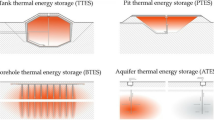Abstract
New challenges—including the modern urban development policy, formation of the market of energy efficient technologies and different types of equipment of a broad power capacity range, tightening requirements to reliability, quality, and economic accessibility of heat supply—enhance the competitiveness of decentralized heat supply. In addition, its spontaneous growth and not always reasonable implementation lead to unjustified expenses, low efficiency, and ecological inconsistency. This proves the relevance of solving the problems of dividing an urban territory into zones of centralized heating (CH) and decentralized heating (DCH) along with their planning and justification, as well as determining a reasonable level of heat supply centralization and concentration of heat sources' power capacity. Solving these problems using the suggested method will allow optimizing the application areas for various types of heat supply and heat sources, justifying the degree of heat power capacity concentration and the extent of the systems as early as at the phase of a detailed urban planning project and then refining them during the design of urban heat supply systems. This will dramatically improve the reasonability of the decisions made and will simplify the procedure of their implementation. For criteria of limiting the extent (radius) of heat supply systems and defining their type, we suggest using standard values—the density of heat load per unit length of the pipeline and per unit area of urban territory. Standard values must be differentiated across the territory of Russia taking into account regional climatic and economic conditions and unique characteristics of heat supply development in cities and towns. The present article continues and develops the statements made in the previous articles created within the framework of the Theory of Hydraulic Circuits and takes into account the current situation and emerging trends in heat supply.
Similar content being viewed by others
References
“Russian Federal law no. 31 “On heat supply” of July 27, 2010,” in Collection of Legislative Acts of Russian Federation (Yuridicheskaya Literatura, Moscow, 2010), No. 31, Art. 4159.
Russian Federation Government regulation from No. 154 “Requirements for the schemes of heat supply, order of their development and approval” of February 22, 2012,” in Collection of Legislative Acts of Russian Federation (Yuridicheskaya Literatura, Moscow, 2012), No. 10, Art. 1242.
B. L. Shifrinson, Basic Calculation of Heating Systems: Theory and Methods, (Gosenergoizdat, Moscow, 1940) [in Russian].
V. Ya. Khasilev, “Analysis of configuration of non-symmetric heating systems and its application to the choice of power of centralized heat supply systems,” Izv. Otd. Tekhn. Nauk, Akad. Nauk SSSR, Nos. 10–11, 1105–1114 (1945).
V. G. Semenov and R. N. Razorenov, “Express-analysis of the dependence of efficiency of heat transport from the consumer remoteness,” Nov. Teplosnabzheniya, No. 6, 36–38 (2006).
V. N. Papushkin, “Radius of heat supply. Very well forgotten the old,” Nov. Teplosnabzh., No. 9, 44–49 (2010).
S. V. Dubovskii, M. E. Babin, A. P. Levchuk, and V. A. Reisig, “Boundaries of economical appropriateness of centralization and decentralization of heat supply,” Nov. Teplosnabzh., No. 6, 14–17 (2012).
Yu. V. Kozharin, “On the question of determination of effective radius of heat supply,” Nov. Teplosnabzh., No. 8, 30–34 (2012).
S. A. Baibakov, K. V. Filatov, and E. A. Subbotina, “Optimization of heat supply systems according to the expenses on heat carrier transportation (Optimization of heat transportation),” Energetik, No. 12, 26–33 (2012).
V. N. Papushkin, A. P. Shcherbakov, and A. S. Grigor’ev, “Problems of heat supply schemes. Determination of effective radius,” Nov. Teplosnabzh., No. 11, 9–14 (2013).
B. N. Gromov, M. A. Serdyukova, and A. M. Kashlev, “On the radius of radius of effective heat supply,” Nov. Teplosnabzh., No. 7, 22–27 (2014).
V. N. Papushkin, S. O. Polyantsev, and A. P. Shcherbakov, “Method of calculation of effective heat supply radius for heat supply schemes,” Nov. Teplosnabzh., No. 9, 44–47 (2014).
V. V. Klyukvin and V. I. Subbotin, “Development of method of determination of effective heat supply radius,” Nadezhn. Bezopasn. Energ., No. 1, 58–62 (2015).
A. D. Plakhuta, “Determination of effective heat supply zones,” Prom. Energ., No. 4, 2–8 (2015).
L. A. Melent’ev, Central Heating, Parts I, II (Academy of Sciences of Soviet Union, Moscow, 1948) [in Russian].
S. F. Kop’ev, Heat Supply, (Gosstroiizdat, Moscow, 1952) [in Russian].
L. S. Khrilev and I. A. Smirnov, Optimization of Central Heating Systems and Centralized Heat Supply, (Energiya, Moscow, 1978) [in Russian].
E. Ya. Sokolov, Central Heating and Heat Supply Systems, (National Research University “MPEI”, Moscow, 1999) [in Russian].
U. Persson and S. Werner, “Heat distribution and the future competitiveness of district heating,” Appl. Energy, No. 88, 568–576 (2011).
U. Persson and S. Werner, “Effective width -the relative demand for district heating pipe lengths in city areas,” in Proc. 12th Int. Symp. on District Heating and Cooling (Tallinn, 2010), pp. 128–131.
District Heating Distribution in Areas with Low Heat Demand Density (International Energy Agency, Paris, 2008).
V. A. Stennikov, E. E. Iakimetc, and S. V. Zharkov, “Optimal Planning of Cities Heat Supply,” Prom. Energ, No. 4, 9–15 (2013).
V. Stennikov and E. Iakimetc, “Search for optimal value of criterion for rational area zoning by type of heat supply,” in Proc. “The Energy Debate: Challenges and Alternatives” (PRESCO-2012) (Hiroshima, 2012), pp. 90–95.
V. A. Stennikov, T. B. Oshchepkova, and N. V. Stennikov, “Optimal expansion and reconstruction of heat supply systems: methodology and practice,” Int. J. Energy Optimiz. Engin. 2, 59–79 (2013).
A. P. Merenkov and V. Ya. Khasilev, Theory of Hydraulic Circuits, (Nauka, Moscow, 1985) [in Russian].
E. V. Sennova and V. G. Sidler, Mathematical Simulation and Optimization of Developing Heat Supply Systems, (Nauka, Novosibirsk, 1985) [in Russian].
Reliability of Heat Supply Systems: Handbook, Ed. by E.V.Sennova (Nauka, Novosibirsk, 2000) [in Russian].
Author information
Authors and Affiliations
Corresponding author
Additional information
Original Russian Text © V.A. Stennikov, E.E. Mednikova, 2016, published in Teploenergetika.
Rights and permissions
About this article
Cite this article
Stennikov, V.A., Mednikova, E.E. Analysis of trends in the development of cities’ heat supply systems. Therm. Eng. 63, 657–665 (2016). https://doi.org/10.1134/S0040601516090068
Published:
Issue Date:
DOI: https://doi.org/10.1134/S0040601516090068




